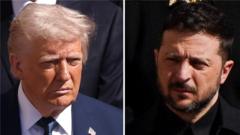During a visit to Italy for the funeral of Pope Francis, President Trump had a pivotal meeting with Ukrainian President Volodymyr Zelensky, marking their first in-person discussion since tensions escalated earlier this year. The encounter is seen as significant given the context of a new cease-fire proposal concerning the ongoing conflict in Ukraine and the broader implications for U.S.-Russia relations.
Trump's Meeting with Zelensky During Vatican Visit Sparks Global Interest

Trump's Meeting with Zelensky During Vatican Visit Sparks Global Interest
President Trump's encounter with Ukraine's Zelensky amidst Pope Francis' funeral highlights pressing geopolitical tensions.
On April 26, 2025, President Trump arrived in Rome for the funeral service of Pope Francis. While attending the service, Trump took the opportunity to meet privately with President Zelensky, an interaction that has raised eyebrows against the backdrop of recent U.S.-Ukraine relations, which suffered a notable setback following a heated televised altercation in February.
Although the White House has not disclosed specific details of the meeting, spokesman Stephen Cheung described it as a “very productive discussion.” The timing is particularly crucial as it coincides with a U.S. proposal for a cease-fire in the ongoing war in Ukraine, which has dramatically shifted the U.S. position regarding Russia’s actions in the region. The plan notably endorses the controversial idea of formally accepting Crimea as Russian territory, a move that may redefine international norms around territorial integrity and provocation.
Trump had initially indicated his desire to visit the Middle East first, specifically Saudi Arabia, during this term, but the death of Pope Francis redirected his itinerary to Vatican City to pay his respects. As he participated in the funeral, he was surrounded by leaders from Europe and the European Union—states he has previously criticized for their perceived lack of contribution to shared defense efforts.
This significant meeting underscores the complexities of current geopolitics, particularly in relation to the U.S. stance towards Eastern Europe and Russia, and the potential shifts in alliances that could arise from ongoing international negotiations.























